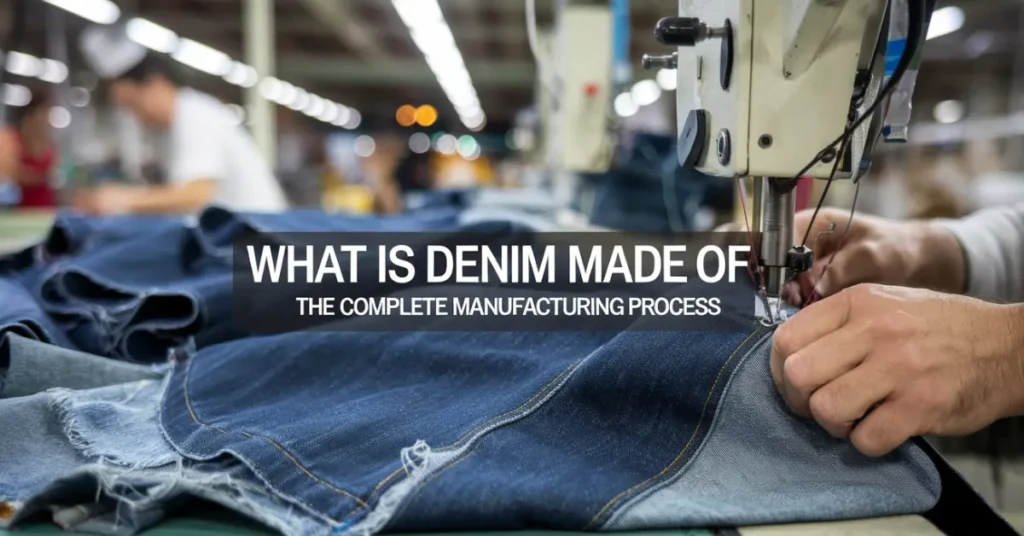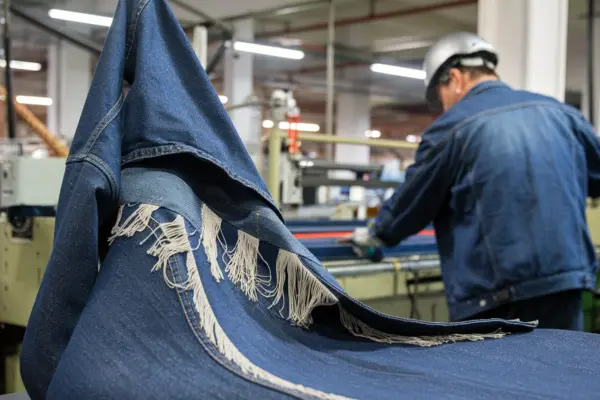Zakir Hossain
Deputy General Manager
Pioneer Denim Ltd.
BSc in Textile Engineering
University of Chittagong
Denim is a strong cotton fabric known for its durability. It is used in jeans, jackets, and other garments. At Pioneer Denim Limited, I was involved in manufacturing high-quality denim using efficient and sustainable methods.

This article explains denim’s composition, how it is made, and sustainable practices in the industry. Whether you are an expert or a learner, this guide will give you clear insights into denim manufacturing.
What is Denim?
Denim is a cotton fabric woven with a diagonal Z twill pattern. This weave makes it stronger than plain-weave fabrics. The term “denim” originates from the French phrase de Nîmes, referring to the city of Nîmes where the fabric was first produced. Denim was the workwear of a coal worker. Over time, denim has become synonymous with rugged workwear and fashion-forward designs.
Expert Comment on Denim Definition
“Denim’s blue color comes from indigo dye, texture from twill diagonal weave. But modern innovations allow for eco-friendly alternatives.” – Jane Smith, Fabric Specialist
Denim vs. Other Fabrics
Denim has a unique twill texture with an indigo-faded design. It is more durable than plain-weave cotton. The diagonal ribbing in denim gives it its signature texture.

What is Denim Made Of?
Cotton: The Primary Material
Denim is usually made from cotton, but it can also contain synthetic fibers (e.g: Polyester, Rayon). The quality of the cotton affects the strength and comfort of the fabric.
- Cotton: The main material, providing durability and flexibility.
- Recycled Denim: Used to reduce waste and support sustainability.
Indigo Dye: The Classic Blue Color
- Traditional denim is dyed with indigo, originally from the Indigofera plant.
- Modern denim uses synthetic indigo for better consistency.
- Some manufacturers use sulfur dyes for black, brown, and green shades.
Synthetic Fibers for Extra Features
To enhance denim’s properties, manufacturers blend it with synthetic fibers:
- Polyester: Adds strength and reduces shrinkage.
- Elastane (Spandex/Lycra): Provides stretch and flexibility.
- Tencel: A sustainable fiber that improves softness.
Finishing Agents for Fabric Treatment
Denim undergoes finishing processes to achieve different textures:
- Softener treatments improve comfort.
- Enzyme washing creates a worn-in effect.
- Sanforization minimizes shrinkage.
Denim Manufacturing Process
Denim production involves multiple stages, from cotton processing to final fabric treatment.
1. Spinning: Turning Cotton into Yarn
- Cotton fibers are cleaned and spun into yarn.
- Ring-spun yarn is stronger and softer than open-end spun yarn.
2. Dyeing: Applying Indigo Color
- Rope dyeing and slasher dyeing are common methods.
- Multiple dips in indigo dye create a deep blue shade.
3. Weaving: Creating the Fabric
- Twill weave strengthens the fabric.
- Selvedge denim is woven on shuttle looms for a clean edge.
- Wider looms produce denim for large-scale production.
4. Pre-Finishing: Stabilizing the Fabric
- Sanforization prevents shrinkage.
- Mercerization enhances dye absorption and shine.
5. Washing & Finishing: Final Appearance
- Stone washing and enzyme washing create softness.
- Acid washing gives a vintage effect.
- Laser and ozone treatments offer eco-friendly alternatives.
Sustainability in Denim Production
Manufacturers focus on reducing water use, chemicals, and waste to make denim production eco-friendly.
Water & Energy Efficiency
- Waterless dyeing and ozone washing reduce water consumption.
Eco-Friendly Materials
- Natural indigo and plant-based dyes replace synthetic dyes.
- Recycled cotton is used to minimize waste.
Recycling & Upcycling Denim
- Old denim is reused for new garments or insulation.
- Recycled denim supports a circular economy.
Challenges & Future Trends
Reducing Chemical Use
- Manufacturers are replacing harsh chemicals with eco-friendly alternatives.
Smart Denim Innovations
- Moisture-wicking and temperature-regulating fabrics are becoming popular.
- Nanotechnology is used to make self-repairing fabrics.
Automation in Denim Production
- AI-driven machines improve cutting and stitching efficiency.
- 3D weaving is changing fabric construction methods.
Conclusion
Denim manufacturing has evolved from traditional methods to modern, sustainable techniques. By focusing on material quality, efficient processes, and sustainability, the denim industry continues to advance.
For a more detailed guide, download the Denim Manufacturing Process Flow Chart for step-by-step details.
For more technical insights, check out the Denim Fabric Specification and Denim Fabric Types PDF, which provides details on different denim varieties and their applications.

Hi, I am Belle Chan, the Manager of Liguotai Imp & Exp Co., Ltd. Established in 1996, our company is located in Shaoxing, Zhejiang, China, LIGUOTAI Company Ltd. Covers an area of 20000 square meters. It has an fixed asset of 3 million U. S. Dollars and 300 workers. Our material department has advanced textile equipments. Our company have a strong ability about making the new proudct. We have professional workers for weaving, printing and dying. The complete sales network, good quality and satisfying services have brought us notable achievement and also help us foster a fairly good and health company image. We mainly make saling fabric for top grade shirts and casual trousers as well as for fashion fabrics.

